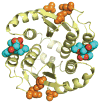Host Factors in Retroviral Integration and the Selection of Integration Target Sites
- PMID: 26104434
- PMCID: PMC4525071
- DOI: 10.1128/microbiolspec.MDNA3-0026-2014
Host Factors in Retroviral Integration and the Selection of Integration Target Sites
Abstract
In order to replicate, a retrovirus must integrate a DNA copy of the viral RNA genome into a chromosome of the host cell. The study of retroviral integration has advanced considerably in the past few years. Here we focus on host factor interactions and the linked area of integration targeting. Genome-wide screens for cellular factors affecting HIV replication have identified a series of host cell proteins that may mediate subcellular trafficking for preintegration complexes, nuclear import, and integration target site selection. The cell transcriptional co-activator protein LEDGF/p75 has been identified as a tethering factor important for HIV integration, and recently, BET proteins (Brd2, 4, and 4) have been identified as tethering factors for the gammaretroviruses. A new class of HIV inhibitors has been developed targeting the HIV-1 IN-LEDGF binding site, though surprisingly these inhibitors appear to block assembly late during replication and do not act at the integration step. Going forward, genome-wide studies of HIV-host interactions offer many new starting points to investigate HIV replication and identify potential new inhibitor targets.
Figures


References
-
- Schwartzberg P, Colecilli J, Goff SP. Construction and analysis of deletion mutations in the pol gene of Moloney murine leukemia virus: a new viral function required for productive infection. Cell. 1984;37:1043–1052. - PubMed
-
- Brown PO, Bowerman B, Varmus HE, Bishop JM. Correct integration of retroviral DNA in vitro. Cell. 1987;49:347–356. - PubMed
Publication types
MeSH terms
Substances
Grants and funding
LinkOut - more resources
Full Text Sources
Research Materials
Miscellaneous

